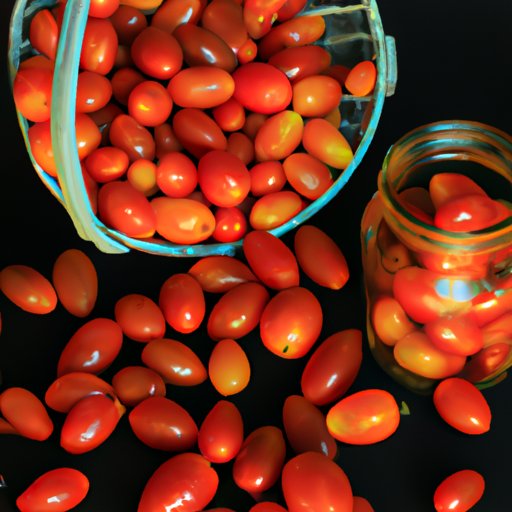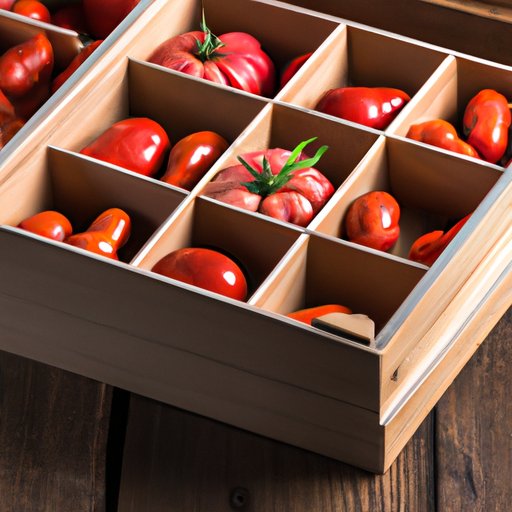Introduction
Tomatoes are a versatile fruit that can be used in an array of dishes, from a simple pasta sauce to a refreshing tomato salad. However, keeping them fresh and juicy can be a challenge. Proper storage is essential to ensure the long-term freshness of tomatoes. In this article, we will provide efficient storage techniques to help extend the life of your tomatoes.

The Basics of Tomato Storage
Before diving into the specifics, it’s essential to understand the basics of tomato storage. Tomatoes are a delicate fruit that requires careful handling to maintain freshness. Here are a few fundamental principles that will help you store your tomatoes successfully:
Storage Method Overview
Tomatoes can be stored in a variety of ways- on the countertop, in the refrigerator, or in a cellar. The ideal storage method depends on the ripeness and intended use of the tomato. For example, refrigeration halts ripening and slows down the decay process; hence, it’s ideal for preserving ripe tomatoes. On the other hand, unripe tomatoes should be stored at room temperature to prevent the texture from becoming mealy.
The Importance of Proper Storage
Improper storage can cause tomatoes to spoil quickly. The shorter the storage time, the better the taste. Furthermore, tomatoes contain ethylene, a naturally occurring gas that speeds up the ripening process in fruits and vegetables. As a result, it’s critical to store tomatoes away from other ethylene-producing fruits, such as bananas, as they can cause tomatoes to ripen and spoil faster.
Tips for Keeping Tomatoes Fresher for Longer
There are various tricks for keeping tomatoes fresher for longer. First, it’s essential to inspect tomatoes regularly and remove specimens that show signs of spoilage. Second, avoid washing tomatoes until ready to use. Wet tomatoes are more prone to spoilage. Finally, use ripe tomatoes quickly; they only last about a week on the kitchen counter or two-three days in the fridge.
The Science Behind Tomato Storage
Various factors play into the proper storage of tomatoes. Understanding how these factors work can help you maximize their shelf life. The three main factors are temperature, humidity, and ethylene.
Role of Temperature in Tomato Storage
Temperature is critical in tomato storage. The ideal storage temperature depends on the ripeness of the tomato and the intended use. Tomatoes that are ripe should be stored in temperatures ranging from 50-55°F to maintain their flavor and prevent decay. On the other hand, unripe tomatoes should be stored at room temperature, between 60-65°F, until they ripen. Avoid storing tomatoes in the fridge for long periods as it can result in a mealy texture and loss of flavor.
Role of Humidity in Tomato Storage
Humidity plays an essential role in controlling the rate of moisture loss in tomatoes. Tomatoes require a medium humidity level ranging from 80-90%. If the humidity is too low, tomatoes will dry out and become shriveled. Excessive humidity can promote spoilage and mold growth. Hence, it’s essential to store tomatoes in a dry place with controlled humidity levels to extend their shelf life.
Role of Ethylene in Tomato Storage
As mentioned earlier, tomatoes produce and are affected by ethylene. While ethylene is essential for the ripening process, too much of it can cause tomatoes to ripen and spoil faster. Avoid storing tomatoes with ethylene-producing fruits such as bananas, apples, and pears, as it can lead to faster decay.
The Importance of Tomato Placement
The proper placement of tomatoes is crucial in maximizing their shelf life. Here are a few tips for finding the perfect spot to store your tomatoes:
Finding the Ideal Storage Spot in the Kitchen
Tomatoes should be stored in a cool, dry place away from direct sunlight. The kitchen countertop is an ideal location, provided it’s not near any heat sources. Alternatively, you can store them inside a pantry or a cellar, provided the temperature and humidity levels are controlled.
Tips on Avoiding Certain Spots for Storage
It’s essential to avoid storing tomatoes near heat sources, such as stoves or ovens, as they can cause them to ripen and spoil faster. Avoid direct sunlight as well, as it can cause the tomatoes to become too warm and spoil. Finally, avoid placing tomatoes near ethylene-producing fruits and vegetables.
Explanation of How Placement can Impact Storage Lifespan
The placement of tomatoes can significantly affect their lifespan. If you store them in a spot that is too warm, they will ripen and spoil faster. Additionally, placing them near heat sources or direct sunlight can cause the tomatoes to become too warm, leading to faster decay. The correct placement, coupled with the ideal storage method, can extend a tomato’s lifespan by several days.
Best Practices for Storing Tomatoes
Here are a few tips on the best practices for storing tomatoes, which will help extend their freshness:
Wrapping and Stacking Techniques
Wrapping tomatoes helps prevent moisture loss, which can lead to spoilage and a mealy texture. You can wrap them in a clean, dry kitchen towel or place them in a brown paper bag. Stacking tomatoes can also extend their shelf life as it helps prevent them from getting crushed or bruised.
Methods for Extending the Shelf Life of Tomatoes
If you need to store tomatoes for an extended period, it’s essential to preserve their quality. Blanching and freezing tomatoes can keep them fresh for up to six months. Additionally, you can pickle or can tomatoes to help preserve them for later use.
Tips for Avoiding Common Mistakes in Tomato Storage
Avoid washing tomatoes until necessary to avoid moisture accumulation. Don’t place too many tomatoes in one bag to prevent weight-induced bruising. Finally, avoid storing tomatoes in the fridge for long periods, as it can cause the tomatoes to become mealy and lose flavor.
Creative Ways to Use Up Extra Tomatoes
If you have an abundance of tomatoes, here are a few creative ways of using them up:
Freezing and Canning Methods
Freezing and canning tomatoes can help preserve their quality for months. You can make homemade pasta sauce, canned tomato salsa, or canned crushed tomatoes from excess tomatoes.
Recipes for Utilizing Excess Tomatoes
There are numerous recipes that use tomatoes as the main ingredient- you can make everything from roasted tomato soup to a simple tomato salad. Additionally, you can make a homemade canned tomato sauce.
Tips for Storing Tomatoes in Alternative Ways
Another way to store tomatoes is to sun-dry them. Tomatoes that are sun-dried last for months and are ideal for use in pasta dishes, salads, and baked goods. If you have a dehydrator, you can also use it to dry tomatoes.
How to Determine if a Tomato has Gone Bad
Here are a few signs to look out for:
Signs to Look Out For
- Wrinkling and shriveling of the skin
- Soft, squishy spots or bruises
- Mold growth on the skin or interior
- Foul or off-putting odor
Explanation of When to Toss a Tomato
If you notice any of the above signs, it’s time to discard the tomato. Consuming overripe or spoiled tomatoes can result in food poisoning or other health issues.
Frequently Asked Questions about Tomato Storage
Expert Tips for Common Tomato Storing Issues
For excessively ripe tomatoes, it’s recommended that you use them immediately or blanch and freeze them within two to three days. Additionally, storing tomatoes with ethylene-absorbing materials such as activated carbon can help extend their shelf life.
Answers to Common Questions about Storing Tomatoes
- What is the best way to store ripe tomatoes?
- The best way to store ripe tomatoes is on the countertop at room temperature. If you need to store them for more than a few days, you can store them in the fridge.
- How do you store tomatoes in the freezer?
- To store tomatoes in the freezer, it’s best to blanch them first. Plunge them in boiling water for two minutes, then dip them in ice water to stop the cooking process. After blanching, remove the skins and seeds, then store them in freezer-safe bags.
- Is it safe to eat moldy tomatoes?
- No, it’s not safe to eat moldy tomatoes. Consuming moldy food can result in food poisoning or other health issues.
Conclusion
In conclusion, proper storage is critical in maintaining the freshness of tomatoes. Understanding the basics of tomato storage is the first step in ensuring long-term freshness. By following the tips and tricks outlined in this article, you can extend the life of your tomatoes, reduce food waste, and enjoy juicy, flavorful tomatoes in your dishes.
